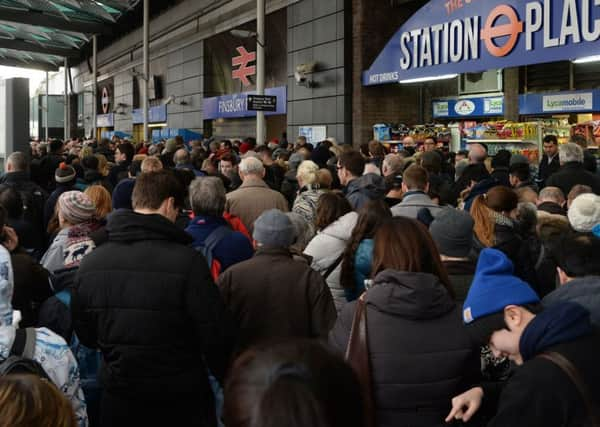Kieran Dunkin: How we’ll avoid a repeat of last year’s trains chaos


We’re delivering new signalling, new bridges, new track and new facilities – all to give passengers better, more reliable journeys.
The investment will benefit millions of people – commuters, families and friends; young or old, north or south, urban or rural. The impact the railway has on this country cannot be overstated.
Advertisement
Hide AdAdvertisement
Hide AdWhether you travel by train regularly or rarely, the railway plays a vital role in all our lives. Passenger numbers have doubled to 4.5 million per day since 1997 and are set to double again in the next 20 years.
Freight trains carrying everything from fuel for our power stations and latest technological gadgets to your weekly grocery shop help contribute £1.6bn to the UK economy. That figure is predicted to rise to £2bn within a decade. Seventy per cent of coal going to power stations travels on our region’s railways.
The demand from passengers and businesses to get more trains on the tracks is why we’re investing record amounts to build a bigger, better railway.
Finding the right time to do that work is one of our biggest challenges. For some, Christmas might be the only time in the year they travel by train, but figures show it is by far the quietest time of the year with passenger numbers down by as much as 50 per cent.
Advertisement
Hide AdAdvertisement
Hide AdWe know that there is no good time to do the essential work that is required, but working at Christmas causes the least disruption. At least, that’s the theory.
The chaos, confusion and anger at Finsbury Park in London last Christmas – when overrunning engineering work near King’s Cross caused massive disruption – remains etched on the minds of all of those who were involved, myself included. The experience endured by the thousands of passengers on December 27 was unacceptable and one the entire rail industry never wants to see repeated. They were the worst few days in my 20 years on the railway.
The reality about major engineering work on the railway at Christmas is that while 95 per cent of the network is unaffected, the five per cent takes years to plan.
We started planning for Christmas 2015 back in 2012, firstly to identify what needed improving, then prioritising which areas needed more work than could be completed over a normal night or weekend shift (we’re out maintaining and improving the network every night of the week, not just bank holidays – last year alone our route teams did 16,000 jobs during evenings and weekends).
Advertisement
Hide AdAdvertisement
Hide AdThen it’s about making sure we have the right equipment – often scarce and highly specialised – and enough sufficiently skilled people. There are over 500 individual worksites running simultaneously over Christmas with 20,000 people to co-ordinate.
On the East Coast Main Line alone, there are six major projects taking place between London King’s Cross and Newcastle, including improving track at Stevenage, points at Doncaster, overhead electric wires at Hitchin and bridges in York and Biggleswade in Bedfordshire.
Each comes with its own set of risks and all must knit together to allow engineering trains carrying parts and equipment to pass through live work sites. A major resignalling project in Lincolnshire and Midland Main Line upgrades need to be factored in too, and then there’s Crossrail and Thameslink.
Plan A is for all 500 work sites to go exactly to plan. But good planning is as much about contingency – plan B. What if a machine fails or a train breaks or a driver phones in sick? What if we get blizzards or floods or gales that stop cranes working? How do problems at one site impact another? At what point can we stop the work or scale it back?
Advertisement
Hide AdAdvertisement
Hide AdWe have spent months analysing every scenario, what the consequences will be and how we deal with it. No stone has been left unturned. Plans A and B are now supported by an entire alphabet of alternatives and, like the railway itself, the decision making process has been vastly upgraded.
The one thread that runs through every project, every review and every decision is simple; what is the impact on passengers? In the past 12 months, we have changed how we deliver major upgrades and are working closely with train operators to make sure that every engineering decision is made with a full understanding of what that will mean for passengers and, crucially, how we are going to communicate with them.
You may have seen our advertising campaign featuring track section manager Barry Robinson from Leeds, part of our efforts to encourage people to check before travelling over Christmas.
Our record since last Christmas suggests we’re now getting it right too. We have successfully completed millions of pounds worth of upgrades in each of the four bank holidays in 2015 without incident and kept passengers moving during the Rugby World Cup.
Advertisement
Hide AdAdvertisement
Hide AdI can say with confidence that every effort has been made to make sure that we’ve learned the lessons from last year, and my colleagues and I will be working hard this Christmas to deliver a better, more reliable railway for 2016 and beyond. Merry Christmas and Happy New Year.
• Kieran Dunkin is Network Rail’s Route Planning Manager for London North Eastern and East Midlands.